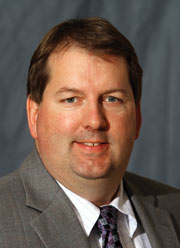Five Minutes With Audio & Video Home
fiveminuteswith
Worker Productivity Strategies with Darin Hargraves
Hargraves discusses his department's efforts to measure and improve the productivity of front-line technicians

Darin Hargraves
Director of Operations,
Anchorage (Alaska) School District,
1. Where does worker productivity fall on your list of management priorities?
Our school district is projecting a $20 million dollar deficit next year, and all departments have been asked to do more with less. To that end, worker productivity has become even more important over the past year. We are looking to make our workers more productive to maintain services, but we also are paying much more attention to productivity as one of our primary key performance indicators, or KPIs. KPIs help us to more effectively manage our operation and make appropriate decisions on staffing levels in buildings. Other KPI include cleaning cost per student and the APPA Cleanliness Rating, to name a few.
2. What formal processes do you use to measure technician productivity?
Worker productivity is a simple calculation of the number of workers divided into the cleanable square footage of a building. Most of our calculations of productivity are done in this fashion — at the building level only — a resource to building assessment. In the past, we have done assessments at the worker level using time-motion studies. These are important when setting up cleaning zones within a school so you don't overload any one employee. This assessment is done using a unitized method — so many classrooms regardless of size, hallways, restrooms, etc., per employee.
We have done much more thorough assessments utilizing ISSA cleaning times and a specialized computer program. One of these was done to evaluate the cleaning program of a 300,000-square-foot high school in conjunction with a union concern, for example. It was very labor intensive, and while the information was near 100 percent in correctness, I don’t think the time and expense is required for most situations from a management perspective.
3. What steps has your department taken to increase productivity?
Adam Smith, in his book The Wealth of Nations, said productivity is reliant on two things: the equipping of the worker and worker training. We focus heavily on equipment because it hard wires productivity. A riding autoscrubber is simply more efficient that a walk-behind in a large high school for example, regardless of the employee. Training is also important, and we spend a lot of time doing it, not only to keep our workers efficient but also for safety. Training is also necessary as we implement more team cleaning in our larger schools and explore new approaches to cleaning our facilities.
4. What role does technology (CMMS, building automation systems, etc.) play in increasing worker productivity?
We currently use software to run our operation but we have not fully implemented the tasking portion of the software. Building automation does not affect the productivity of our workers but is becoming a huge consideration as we move to save money. One of the new cleaning approaches we are considering is day cleaning of schools. If we could shut down, via automation, our schools earlier in the day, our district could potentially save millions. We currently spend about $16 million on utilities each year. Our high schools consume nearly $2,000 a day in electricity alone. Moving cleaning times would result in savings.
5. Overall, how do you measure the effectiveness of your efforts?
What we found, and try to assess, is the relationships between various KPIs. A school running at near 100 percent capacity is going to be dirtier than one run at 70 percent, for example. This multi-dimensional perspective has served us well and is making the management of our department easier during these tough times. We may, at some point, need to make tough decisions, but this assessment philosophy will equalize the process fairly across the district and between facilities.
Find more on this topic:
productivity, personnel, staffing
posted: 11/9/2012








